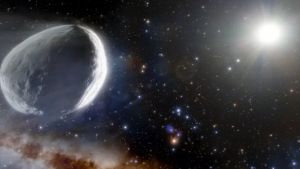JAKARTA - NASA's Hubble Space Telescope has clicked on another cosmic marvel: the interaction of two galaxies so closely intertwined that they are collectively labeled as one entity.
Galactic interactions are not a rare phenomenon. In fact, a large number of galaxies exhibit some form of interaction either with their satellites or on a much larger scale with other galaxies. The latter category can include events such as collisions that end in the merging of galaxies or lead to explosions of star formation.
In a collision and eventual merger scenario, the larger galaxy might retain its shape after devouring a much smaller galaxy. Gravitational interactions between galaxies often lead to the formation of larger irregular galaxies, but elliptical galaxies are also known to form as a result.
Some of the best examples of galactic interactions are the Messler group 81 (including the dominant galaxy M81 interacting with the two smaller galaxies NGC 3034 and NGC 3077) and the Cartwheel group of four spiral galaxies in a beautiful ring line.
Images captured by the Hubble Space Telescope show an entity called Arp 91 located more than 100 million light-years from Earth. Arp 91 consists of two spiral galaxies named NGC 5953 and NGC 5954.

In the image above, NGC 5953 is a lower galaxy with higher brightness and a more intact spiral shape. The oval-shaped galaxy at the top is NGC 5954. Interestingly, NASA notes that both galaxies are spiral in shape, but their shape appears to be oddly distorted due to their orientation in space with respect to Earth.
A quick glance at the image shows that the oval-shaped NGC 5954 extends one of its arms towards NGC 5954 due to the strong gravitational interaction between them. Scientists believe that galaxies form arms due to their rotation around a central axis and another factor called density waves.
SEE ALSO:
These arms are active sites of star formation and usually appear brighter because the stars inhabit the region. Interestingly, a recent study revealed that one of the Milky Way's arms was broken.
As per a research paper entitled 'Photometric Traces and Kinematic Interactions' appearing in the Astronomical Society of the Pacific, the two galaxies in the Arp 91 system are separated by a distance of 5.8 kiloparsecs and have prominent star-forming regions. However, based on Infrared Astronomical Satellite (IRAS) data, NGC 5953 has a much higher rate of star formation per unit area compared to its interacting neighbor.
Interestingly, NGC 5953 is said to be below the Seyfert Class II galaxy, which is characterized by its bright core known as the active galactic nucleus (AGN) and happens to be one of the brightest sources of electromagnetic radiation in the cosmos. Interestingly, the Hubble telescope recently captured an image of one of the Seyfert galaxies that looks like a giant cosmic eye with a bright center.
The English, Chinese, Japanese, Arabic, and French versions are automatically generated by the AI. So there may still be inaccuracies in translating, please always see Indonesian as our main language. (system supported by DigitalSiber.id)


















